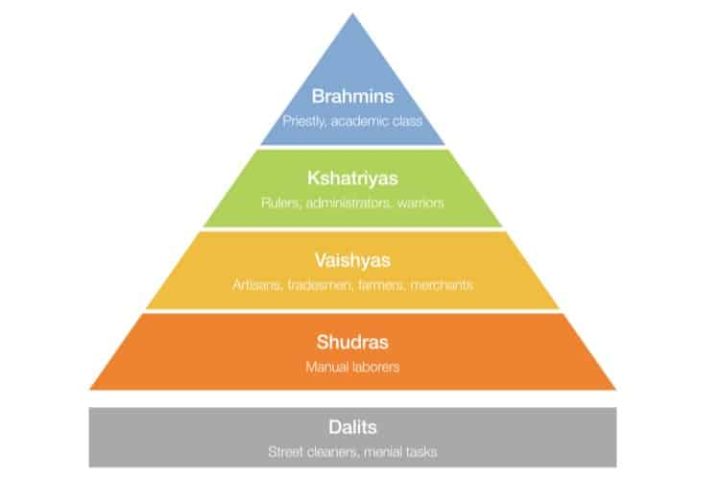
Ninety percent of American Hindus voted for Barack Obama, but this doesn’t mean they subscribe to his anti-discrimination rhetoric (any more than he does). In fact, says an Indian prelate, many of them not only discriminate, but apply what may be the world’s strictest form of discrimination: India’s caste system.
So writes Joseph D’Souza, archbishop of the Anglican Good Shepherd Church of India. He says that even though India has banned “the practice of ‘untouchability,’” it “has not made any dent in the caste mindset of privileged Indians.” And now, via immigration, this system has been brought to our shores.
This problem manifested itself, claims are, at Google headquarters, “where Sunder Pachali, a high-caste Indian, presides,” D’Souza related. “An uproar occurred at Google last April when Google News senior manager Tanuja Gupta invited a Dalit [untouchable] woman speaker to discuss caste discrimination with Google employees as the company hires many employees of Indian descent. Gupta knows the subject well. Her parents immigrated from India decades ago and she herself is an upper-caste woman.”
“Gupta said the talk was planned due to complaints within the company by employees who claimed they were victims of caste discrimination,” D’Souza continued.
(Of course, one could ask why Big Tech is hiring so many foreign workers. The answer is that while there are skilled Americans who need jobs, they’re considered untouchable because they don’t work for the same pay. This is all enabled, too, by the feds’ H-1B visa program.)
But after being planned, the Dalit’s talk was canned. You see, these modern, high-tech employees might have brought the ancient caste system with them from the old country, but in one way they’ve assimilated completely: playing the victim.
That is to say, numerous “employees within the company expressed the view that any talk on caste discrimination was offensive to them as Hindus, and made them feel unsafe,” explained The New Yorker in August. “The talk was eventually cancelled, and Gupta, who had been at Google for more than ten years, resigned amid an investigation into her own behavior. (A spokesperson for Google said that it has ‘a very clear, publicly shared policy against retaliation and discrimination in our workplace.’)”
“Offensive”? Anyone making this claim should simply be told to ponder, deeply, how “Offense cannot be given, only taken.”
Speaking of offenses, the caste system is quintessentially un-American. While our country is beset by Equality Dogma — we forget that equality tells you nothing about quality and is thus irrelevant — the caste system is the other extreme: It creates strict stratification that precludes advancement no matter how gifted a low-caste person may be. The BBC explained the origins and nature of this system in 2019:
The caste system divides Hindus into four main categories — Brahmins, Kshatriyas, Vaishyas and the Shudras. Many believe that the groups originated from Brahma, the Hindu God of creation.
At the top of the hierarchy were the Brahmins who were mainly teachers and intellectuals and are believed to have come from Brahma’s head. Then came the Kshatriyas, or the warriors and rulers, supposedly from his arms. The third slot went to the Vaishyas, or the traders, who were created from his thighs. At the bottom of the heap were the Shudras, who came from Brahma’s feet and did all the menial jobs.
The main castes were further divided into about 3,000 castes and 25,000 sub-castes, each based on their specific occupation.
Outside of this Hindu caste system were the achhoots — the Dalits or the untouchables.
For centuries, caste has dictated almost every aspect of Hindu religious and social life, with each group occupying a specific place in this complex hierarchy.
Rural communities have long been arranged on the basis of castes — the upper and lower castes almost always lived in segregated colonies, the water wells were not shared, Brahmins would not accept food or drink from the Shudras [which just means they weren’t hungry enough], and one could marry only within one’s caste.
The BBC also informs that caste groups still often vote as a bloc. This is ironic since as mentioned earlier, Hindus in the United States also vote as a bloc — for Democrats. In this, though, they do reflect the norm of how the wealthy now support statists (Hindus are our country’s second-highest-earning religious group, next to Jews.)
As for the Google fiasco, Archbishop D’Souza laments that it “does not bode well for Dalits in the U.S. who already struggle as the lowest caste in India. New Indian immigrants in the U.S. who are educated and professionally qualified largely come from the upper caste elite of India. As in India, most of them carry caste prejudice wherever they go. As they continue to move into the upper echelons of American society, the threat is that they bring caste discrimination with them.”
In reality, however, immigrants in America bring whatever they believe with them. This is rarely discussed, too. We’ll talk about immigration’s economic effects or what skills the newcomers boast. But men’s countries, just as with a man himself, don’t live on bread alone. Moreover, talk of “assimilation” is so reflexive that the idea it automatically occurs has become dogma. Yet it’s a two-way street: Immigrants can change their new nation just as they can be changed by it. And as their numbers become greater, they generally change less and their host country more.
Apropos to this, the United States now has 47 million foreign-born residents (legal and illegal), the most in our history and more than any other nation on Earth. What’s more, “since 2000, the total foreign-born population has grown by 50 percent; it’s doubled since 1990, tripled since 1980, and quintupled since 1970,” reported CIS.org in June. Given this and the fact that demography is destiny, a national conversation about what kind of land we want to be — and how (im)migration affects this — is in order. Instead, we’re wringing our hands over how to protect Ukraine’s borders.
As for stratifying standards, the real threat to America is the “caste” discrimination reflected in cancel culture and the multi-tiered, politically driven justice system given to us by statist Democrats — demagogues who, in turn, are given to us with the help of millions of naturalized immigrants’ votes.



